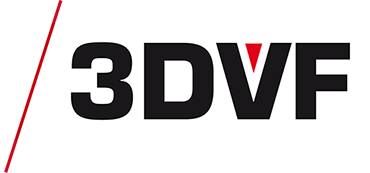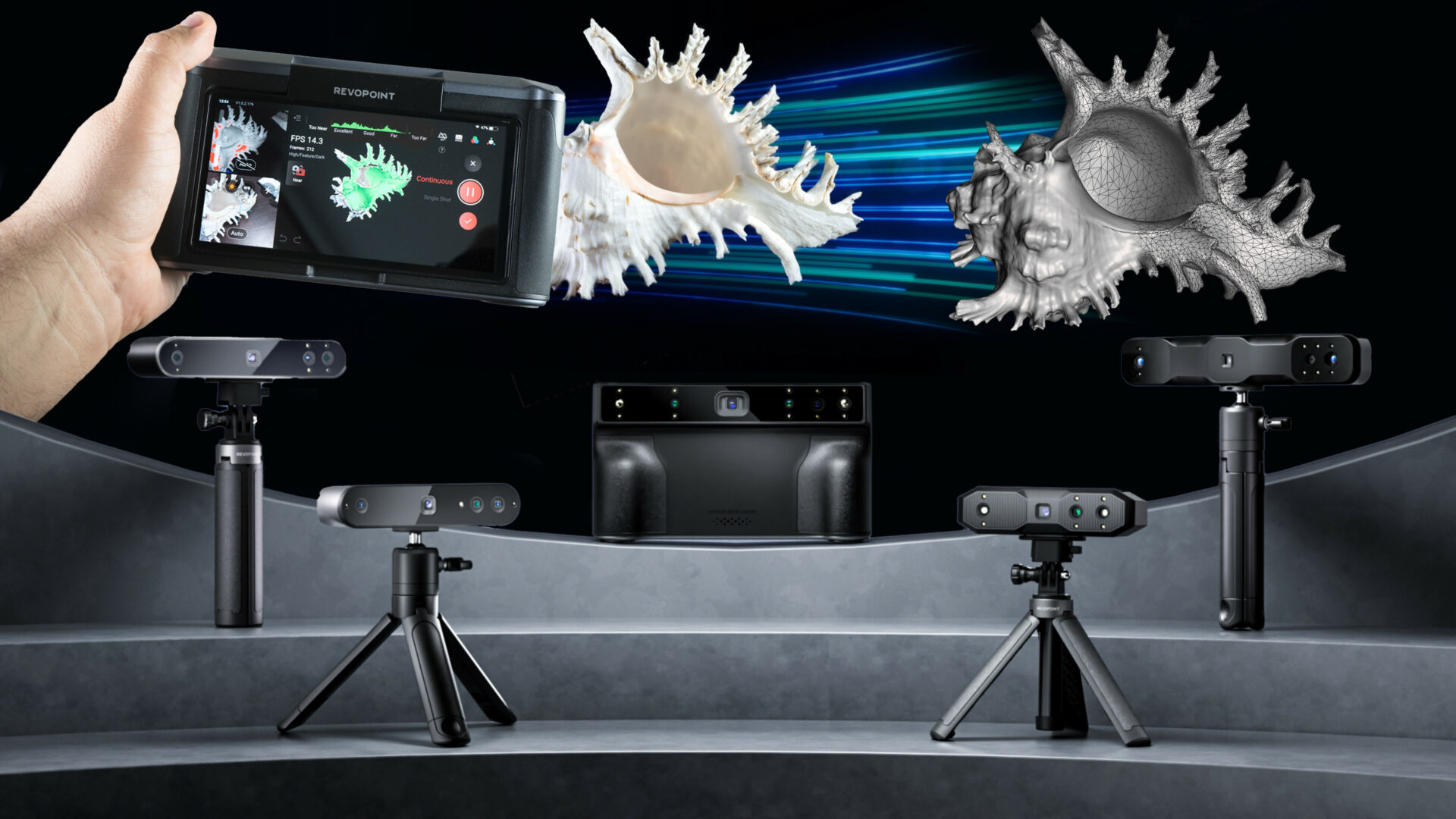This article is also available in:
![]() Français
Français
This article is sponsored by Revopoint
3D scanning is now a very common technique in many fields, from visual effects to heritage to design. But these techniques can be intimidating for beginners: in this article, we will explain why and how 3D scanning has become popular, and how studios and artists can get started at a reasonable cost.
Old origins
3D scanning is nothing new. The first 3D scanners appeared in the 1960s. As early as 1972, Ed Catmull and Fred Parke digitized Catmull’s hand before animating it in 3D.
Over the years, 3D scanning methods have multiplied: laser scanning, structured light, photogrammetry, LiDAR… Advances made possible by the invention of new approaches, technical progress, and the associated cost reductions.
How photogrammetry became popular
Photogrammetry is a very good example of this evolution. The basic principle (using photos to calculate measurements) is very old: as early as 1851, Aimé Laussedat was interested in the possibilities offered by the camera (then film) for mapping. The principle was also used for this purpose in the early 20th century, as mapping became a major issue for nations, including for military use.
From the 1960s onwards, computers became more and more poweful, more and more widespread. Furthermore, space probes made photogrammetry even more relevant. Finally, for the past fifteen years, we have witnessed a massive democratization of this approach: digital cameras, increasing CPU and GPU power have made photogrammetry particularly affordable. Hence its adoption by many sectors, such as visual effects, video games.
Other methods have followed this path: LiDAR, for example, is available on some smartphone models. However, the results remain limited in terms of quality at the moment.
Structured light now accessible
Structured light took time to follow the same path. In the 2010s, for example, there were tools that allowed the use of video projectors to capture the shape of an object, but the procedure was tedious, expensive (the necessary equipment had to be acquired, sometimes by modifying the projector if small objects were to be captured), and required capturing numerous passes to then assemble them. A very tedious task.
At the same time, efficient and functional structured light scanners had existed for a long time but required a heavy investment and a lot of know-how. Studios and companies often preferred to use external service providers.

Above: Revopoint MIRACO
Below: multiple scans created using Revopoint MIRACO. This scanner can be used to scan both small and big objects, and features an all-in-one design. Scans can be processed on a computer for better accuracy. Using Revo Scan, the “advanced” reconstruction mode is recommended for maximum control and detail.
Recommended scanning distance is 100 to 1000mm.



In other words, there were affordable solutions requiring a lot of time and effort and other solutions that were very expensive. Structured light was still “lagging” behind other 3D scanning methods.
The situation has evolved dramatically in recent years. Several manufacturers, such as Revopoint, have listened to market demands and developed compact, very affordable scanners (starting from a few hundred euros). Thanks to technological advances, structured light is becoming truly accessible to artists and studios, without having to make heavy investments or rely on a specialized company every time they want to use this technique.
What’s more: with computer progress, gone are the long sessions of assembling passes that people remember from fifteen years ago. Now, we have real-time preview, frames assemble automatically, and with Revopoint’s Revo Scan software, for example, multiple passes can even be merged in a few clicks. Creating your first scans is fast, and you can progress quickly.
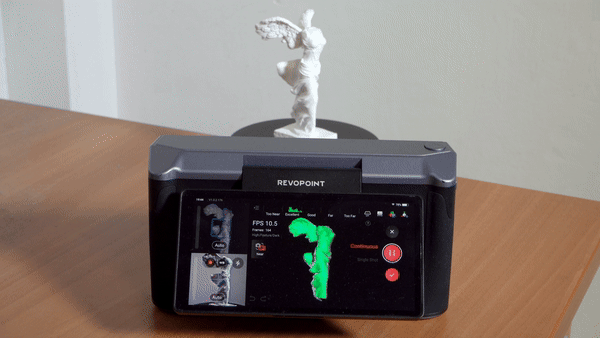
Why affordable 3D scanners are changing the industry
The arrival of low-cost structured light scanners may not seem noteworthy at first, but it has great disruptive potential for several reasons.
- Firstly, photogrammetry shows its limitations in certain situations: obtaining the geometry of a reflective or transparent object, for example, will be complex, whereas 3D scanning spray (which is quite affordable) or even cornstarch will allow the user to easily capture the same object with a structured light scanner. Moreover, if the location is dark and adding light is impossible or prohibited (for example, in a church or museum), photogrammetry becomes impractical, whereas structured light perfectly captures the geometry. Finally, for an object with a uniform color like a car part, structured light will be much more effective.
In short: structured light brings real added value in many situations.

- Furthermore, a structured light 3D scanner is calibrated and produces models to scale from the outset, whereas photogrammetry will require a workflow that can be complex, with scale markers.
These extra step take more time, and human errors along the way can decrease the accuracy. A simple yet efficient workflow is therefore a real advantage that facilitates its use in certain fields: 3D printing, heritage, reverse engineering, scanning for part repair, etc.
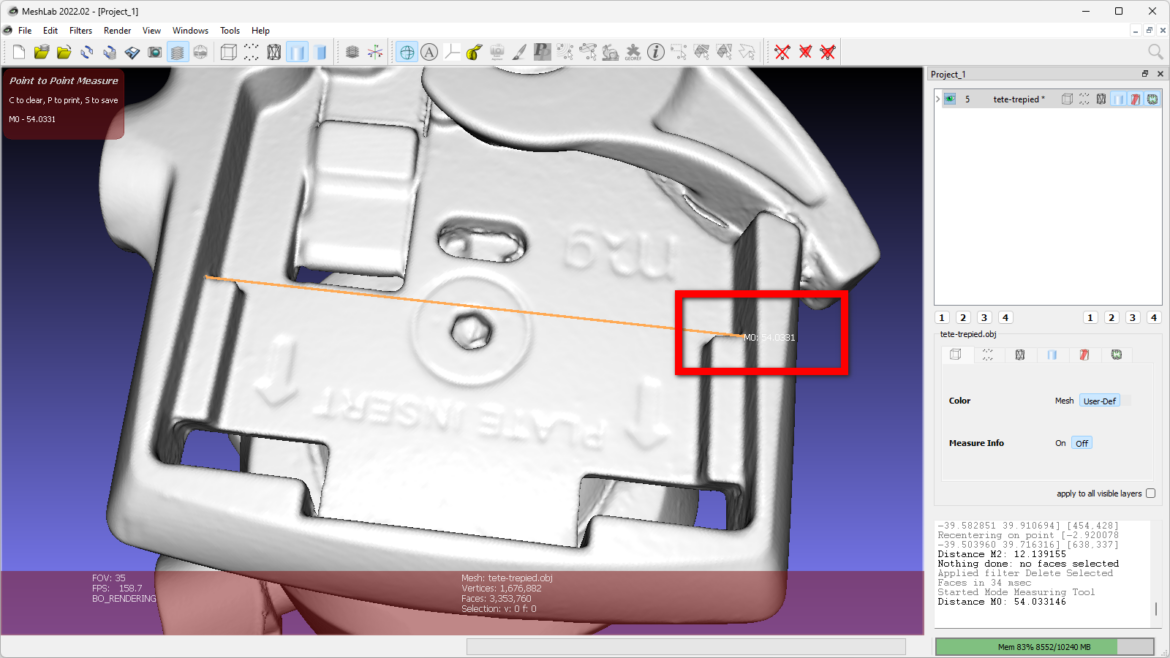
Below: the same tripod head. Width measured using calipers – 54.00mm.

- Portability: low-cost 3D scanners are very compact and can easily be used on the go, for example, at a customer’s office, on a film set, in a museum.
What’s more: with the latest generations of structured light 3D scanners, such as Revopoint INSPIRE, POP 3, RANGE 2, it is possible to scan without a nearby computer by connecting the scanner to a compact external battery and a smartphone running iOS or Android.
Finally, some devices are even completely standalone, like the Revopoint MIRACO, which integrates screen, battery, processor, and storage. The perfect tool to slip into your bag.
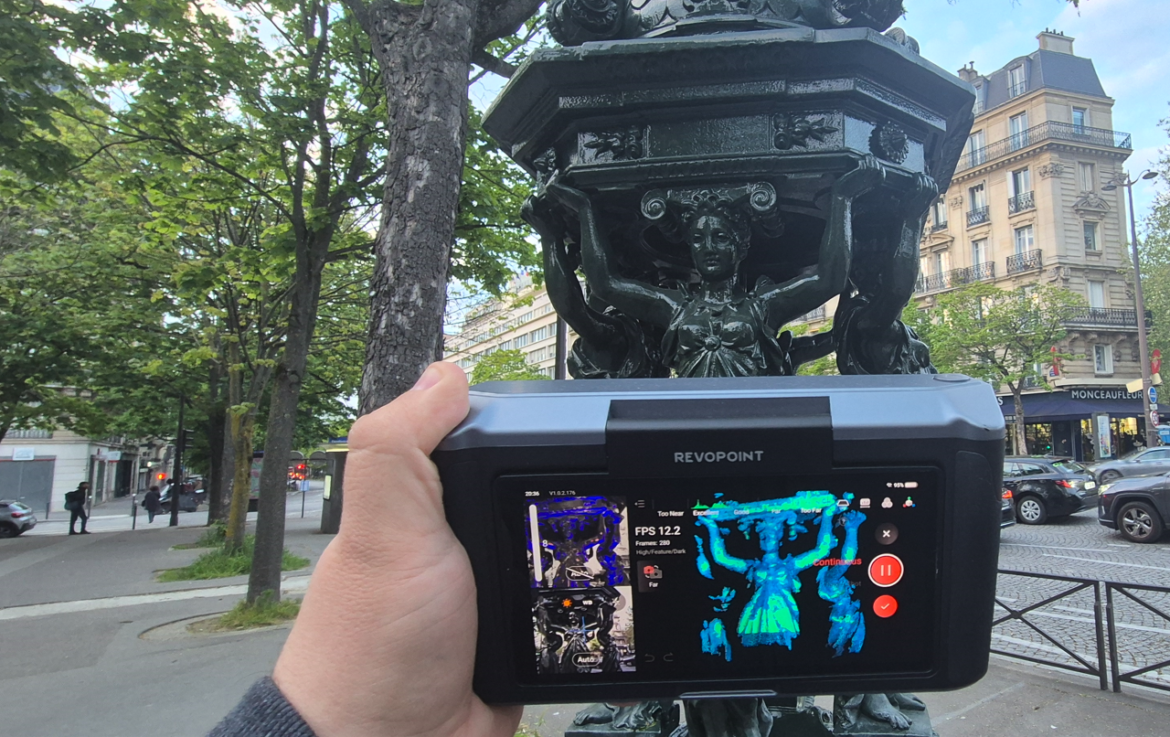
We recommend using it on an overcast day, and/or either erarly in the morning or late in the evening: this way, the sun won’t overpower the infrared light from the scanner.
In other words: structured light is effective, precise (up to 0.02mm for a Revopoint MINI 2, for example), and can be used in situations where photogrammetry does not apply.
The latest generations of scanners, with inertial systems and advanced software, are becoming increasingly intuitive, making them easier for beginners to use.
Even for studios and artists already using photogrammetry, it deserves attention: for example, to be able to scan objects difficult to digitize by photogrammetry, or by combining the two approaches.

We find ourselves in a situation similar to the arrival of affordable motion capture that allowed studios to use it without having a complex and expensive setup. A wide range of artists, studios and companies from different industries will be able to use structured light scanning.
For example:
- a museum that will finally be able to digitize its collections, despite a limited budget. Revopoint MIRACO, for example, is the perfect tool for capturing 3D models that can be shared online, without having to rely on a third party company with very high-end equipment;
- visual effects studios will be able to digitize assets without relying on an external service provider;
- much more affordable reverse engineering;
- new opportunities for people who have created a business around the sale of 3D printing and are looking for new models to offer;
- the possibility, with Revopoint RANGE 2, to easily scan humans, for example, to turn them into MetaHumans using Epic Games tools. Perfect for creating digital doubles usable in visual effects, for a video game studio, or in 3D animation. And with motion capture tools available for Metahumans, animating these 3D models will be child’s play.
You can watch below an example of a human scanned using a Revopoint scanner, turned into a MetaHuman. Lip-sync animation was achieved using NVIDIA Audio2Face and a sample audio file in just a few clics.
- virtual reality/mixed reality experiences are another interesting application for 3D scans. You can easily turn your scans into USDZ files (for example by uploading them to Sketchfab or by using Substance 3D Painter) which can be displayed on the Apple Vision Pro. Using this device, you can even anchor the scans in your living room and admire your asset!
Furthermore, Apple provides a dedicated tool, Reality Composer Pro, if you want to develop and create spatial apps for visionOS. Which means that you can turn your 3D scans into fully-fledged immersive experiences. Advanced users and studios can therefore use 3D scanning to create their own assets, then develop apps and games for the Apple Vision Pro.
Artists, enthusiasts wanting to turn 3D scanning into a small business, studios wanting to start at a lower cost, heritage sectors, design, VFX, animation… Many audiences will benefit from these new tools.
3D scanning: what’s ahead?
As we have seen, the progress made in recent years makes 3D scanning technologies, once prohibitively expensive, much more accessible. Not to mention the significantly improved ease of use.
The expansion of use cases and target audiences, thanks to the improvement of available scanners and price reductions, will no doubt create interesting surprises for the years to come. And the regular improvement of scanners, with companies like Revopoint competing imaginatively to improve both the hardware and associated software, promises continuous improvements.
So don’t hesitate to get started. Here is a breakdown of the Revopoint lineup. You’ll find more information on Revopoint’s official website :
- Revopoint MIRACO.
- Revopoint RANGE 2.
- Revopoint POP 3.
- Revopoint MINI 2.
- Revopoint INSPIRE.
- Official website.
| MIRACO | RANGE 2 | POP 3 | MINI 2 | INSPIRE | |
| Application | Small to large sized objects | large sized objects | Medium sized objects | Small to very small objects | Medium sized objects |
| Color scanning / RGB camera resolution | Yes, 48 Megapixels | Yes, 2 Megapixels | Yes, 1 Megapixel | Yes, 2 Megapixels | Yes, 1 Megapixel |
| Scanning Mode | Continuous, single shot | Continuous | Continuous | Continuous | Continuous |
| Outdoor scanning (overcast sky) | Yes | Yes | Yes | No | Yes |
| Strongest selling point | Flagship, standalone unit, very vesatile, large screen. | Perfect for large objects and humans. | A good scanner for medium-sized objects. | The go-to solution if you want to focus on small subjects & need high precision. | The most affordable Revopoint scanner: a good choice for beginners. |
